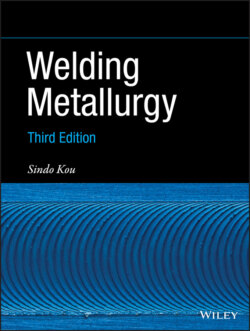Читать книгу Welding Metallurgy - Sindo Kou - Страница 37
1.3.4.3 Modes of Metal Transfer
ОглавлениеThe molten metal at the electrode tip can be transferred to the weld pool by three basic transfer modes: globular, spray, and short‐circuiting:
1 Globular transfer. Discrete metal drops close to or larger than the electrode diameter travel across the arc gap under the influence of gravity. Figure 1.20a shows globular transfer during GMAW of steel at 180 A and with Ar–2% O2 shielding [11]. Globular transfer is often not smooth and produces spatter. At a relatively low welding current globular transfer occurs regardless of the type of the shielding gas. With CO2 and He, however, it occurs at all usable welding currents. As already mentioned, a short buried arc can be used in CO2‐shielded GMAW of carbon and low‐alloy steels to minimize spatter.
2 Spray transfer. Above a critical current level, small discrete metal drops travel across the arc gap under the influence of the electromagnetic force at a much higher frequency and speed than in the globular mode. Figure 1.20b shows spray transfer during GMAW of steel at 320 A and with Ar–2% O2 shielding [11]. Spray transfer is much more stable and spatter free. The critical current level depends on the material and size of the electrode and the composition of the shielding gas. In the case of Figure 1.20, the critical current was found to be between 280 and 320 A [11].
3 Short‐circuiting transfer. The molten metal at the electrode tip is transferred from the electrode to the weld pool when it touches the pool surface, that is, when short circuiting occurs. Short‐circuiting transfer encompasses the lowest range of welding currents and electrode diameters. It produces a small and fast‐freezing weld pool that is desirable for welding thin sections, out‐of‐position welding (such as overhead‐position welding) and bridging large root openings in multiple‐pass butt welding with a V‐groove.
Figure 1.20 Metal transfer during GMAW of steel with Ar–2% O2 shielding: (a) globular transfer at 180 A and 29 V shown at every 3 × 10−3 s; (b) spray transfer at 320 A and 29 V shown at every 2.5 × 10−4 s.
Source: Jones, Eagar and Lang [11]. Welding Journal, April 1998, © American Welding Society.
